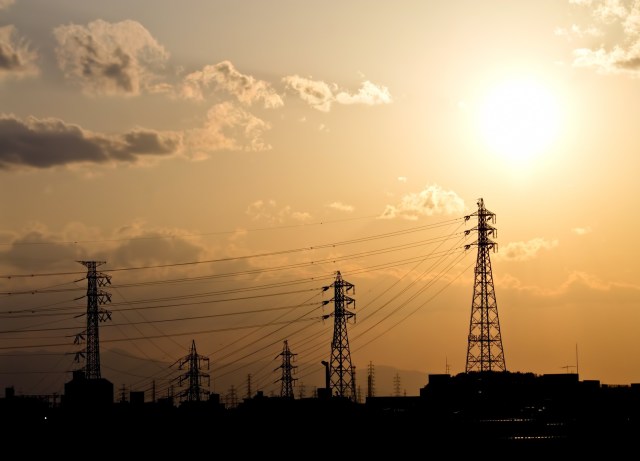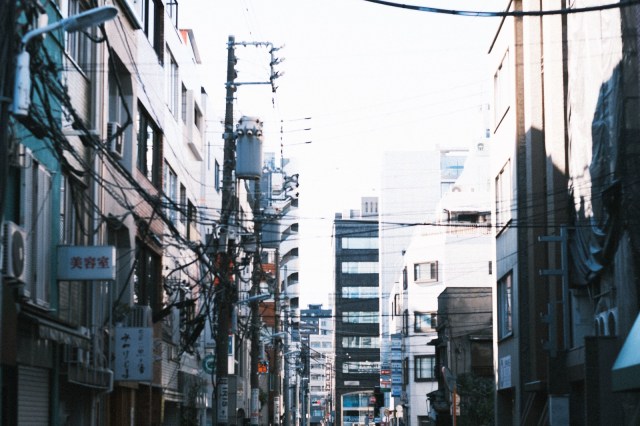
The move is intended to minimize damage during natural disasters, but is it too little too late?
No matter where you travel in Japan, you’re likely to see one familiar sight wherever you go—utility poles, threaded together by thick power cables. These cables carry electricity all over the country and are much cheaper to install and reach for repairs than their underground counterparts. A country that works late into the night and begins again early the next morning needs a stable system to transport all that power to where it’s needed. But unfortunately, overhead power lines aren’t without their risks. They’re easily threatened by natural disasters like earthquakes, typhoons, and tsunamis, which can dislodge them and disrupt power service on a huge scale.
So why is Japan still using them? Well, the issue is that changing from overhead to underground power lines is no small feat, and it has an appropriately huge price tag to match. Though talk of removing power lines have increased in surrounding the Tokyo Olympics, the huge utility poles are still looming all over Japan. It takes time not only to remove the power cables themselves but also to implement new cables into an underground system that already includes a thriving network of water and gas pipes.
The Ministry of Land, Infrastructure, Transport, and Tourism has, however, announced a new plan to eliminate 4,000 kilometers (2485.48 miles) of overhead power cables at sites across the nation by 2025. Their priority will be areas around roads that help to transport goods in the case of emergency situations, as well as cables along roads leading to World Heritage Sites and other popular tourist destinations. They cited improved disaster response and beautifying the landscape as the motivating factors behind the plan.
▼ Citizens often complain about the clutter of utility poles and cables alike.
Running counter to this is the fact that around 70,000 new utility poles are installed every year. The government assures that they will be interacting with power companies to try to bring this number down and seek out alternatives for transmitting energy across the nation.
The issue of power cables has earned much more attention in recent years, especially after a typhoon in September 2019 that left vast areas of Chiba prefecture without power. While the new plan aims to address critical areas for disaster response, citizens have criticized both the relatively small scale of the cable removal and the long window of projected time it will take to even remove that. On the other side of the debate, there are also people staunchly against the implementation of underground cables, who imply that the much greater ease of repair to overhead lines more than offsets their higher risk of being damaged in the first place.
“Just 4,000 kilometers? Isn’t it way too late for that? And when are they planning to start? Hurry up and get it over with already!”
“The Ministry of Finance better not get in the way of this. Heck, they should double their budget for it.”
“This is just gonna make it even harder to restore power after earthquakes or natural disasters. Stop this plan.”
“It’s not exactly encouraging to think that it’ll take five years just to get rid of 4,000 kilometers…”
For every person who complains about how ugly the overhead cables look, there is another arguing that the utility poles supporting them are important to mark streets or provide light. The ultimate fate of Japan’s overhead power cables remains in the dark for now, but we’re eager to see how what changes may happen in the next four years.
Source: NHK News Web via Otakomu
Top image: Pakutaso
Insert image: Pakutaso
● Want to hear about SoraNews24’s latest articles as soon as they’re published? Follow us on Facebook and Twitter!


 Why does Japan have so many overhead power lines?
Why does Japan have so many overhead power lines? Fukuoka City aims to resume traffic at site of road collapse less than a week after accident
Fukuoka City aims to resume traffic at site of road collapse less than a week after accident Japanese researchers redesign electric car to go farther than ever before on a single charge
Japanese researchers redesign electric car to go farther than ever before on a single charge Strong earthquake hits Japan as anniversary of Fukushima disaster approaches【Photos, Videos】
Strong earthquake hits Japan as anniversary of Fukushima disaster approaches【Photos, Videos】 Five beautiful pylon designs that belong in Japan
Five beautiful pylon designs that belong in Japan How to order snacks on a Shinkansen bullet train in Japan
How to order snacks on a Shinkansen bullet train in Japan Burger King Japan suddenly adds Dr. Pepper and Dr. Pepper floats to its menu nationwide
Burger King Japan suddenly adds Dr. Pepper and Dr. Pepper floats to its menu nationwide New Nintendo Lego kit is a beautiful piece of moving pixel art of Mario and Yoshi【Photos】
New Nintendo Lego kit is a beautiful piece of moving pixel art of Mario and Yoshi【Photos】 Hello, cosmetics! Clinique teams up with Hello Kitty this summer for first-time collaboration
Hello, cosmetics! Clinique teams up with Hello Kitty this summer for first-time collaboration Demon Slayer: Kimetsu no Yaiba gets new roller coaster attractions and food at Universal Studios Japan
Demon Slayer: Kimetsu no Yaiba gets new roller coaster attractions and food at Universal Studios Japan 11 different ways to say “father” in Japanese
11 different ways to say “father” in Japanese Kyoto tea merchant’s matcha parfait ice cream bars: The desserts we’ve been waiting 187 years for
Kyoto tea merchant’s matcha parfait ice cream bars: The desserts we’ve been waiting 187 years for East meets West in the Pacific-centered version of the world map
East meets West in the Pacific-centered version of the world map What do you eat when you catch a cold? We asked 11 of our Japanese reporters
What do you eat when you catch a cold? We asked 11 of our Japanese reporters Shinjuku izakaya’s all-you-can-eat-and-drink plan is one of Tokyo’s best secret cheap eats
Shinjuku izakaya’s all-you-can-eat-and-drink plan is one of Tokyo’s best secret cheap eats Nintendo history you can feel – Super NES, N64, and GameCube controllers become capsule toys
Nintendo history you can feel – Super NES, N64, and GameCube controllers become capsule toys “The most Delicious Cup Noodle in history” – Japan’s French Cup Noodle wins our heart【Taste test】
“The most Delicious Cup Noodle in history” – Japan’s French Cup Noodle wins our heart【Taste test】 Starbucks releases a cute Frappuccino and Unicorn Cake…but not in Japan
Starbucks releases a cute Frappuccino and Unicorn Cake…but not in Japan Kyoto Tower mascot termination reveals dark side behind cute Japanese characters
Kyoto Tower mascot termination reveals dark side behind cute Japanese characters McDonald’s Japan’s Soft Twist Tower: A phantom ice cream only sold at select branches
McDonald’s Japan’s Soft Twist Tower: A phantom ice cream only sold at select branches Yabai Ramen: What makes this Japanese ramen so dangerous?
Yabai Ramen: What makes this Japanese ramen so dangerous? Finally! Nintendo Japan expands Switch 8-bit controller sales to everybody, Online member or not
Finally! Nintendo Japan expands Switch 8-bit controller sales to everybody, Online member or not Japanese government wants to build luxury resorts in all national parks for foreign tourists
Japanese government wants to build luxury resorts in all national parks for foreign tourists To combat declining birth rate, Japan to begin offering “Breeding Visas” to foreigners
To combat declining birth rate, Japan to begin offering “Breeding Visas” to foreigners 10 things you should buy at 7-Eleven in Japan
10 things you should buy at 7-Eleven in Japan Studio Ghibli releases anime heroine cosplay dresses that are super comfy to wear
Studio Ghibli releases anime heroine cosplay dresses that are super comfy to wear Woman charged for driving suitcase without a license in Osaka
Woman charged for driving suitcase without a license in Osaka Studio Ghibli unveils My Neighbour Totoro miniature house model
Studio Ghibli unveils My Neighbour Totoro miniature house model Kyoto experiencing problems with foreign tourists not paying for bus fares, but not on purpose
Kyoto experiencing problems with foreign tourists not paying for bus fares, but not on purpose Fighting mild hunger with a Japanese soda that turns into jelly in the stomach【Taste test】
Fighting mild hunger with a Japanese soda that turns into jelly in the stomach【Taste test】 Studio Ghibli’s Howl’s Moving Castle tapestry unveiled in Japan for first time
Studio Ghibli’s Howl’s Moving Castle tapestry unveiled in Japan for first time McDonald’s new Happy Meals offer up cute and practical Sanrio lifestyle goods
McDonald’s new Happy Meals offer up cute and practical Sanrio lifestyle goods Sales of Japan’s most convenient train ticket/shopping payment cards suspended indefinitely
Sales of Japan’s most convenient train ticket/shopping payment cards suspended indefinitely Sold-out Studio Ghibli desktop humidifiers are back so Totoro can help you through the dry season
Sold-out Studio Ghibli desktop humidifiers are back so Totoro can help you through the dry season Japanese government to make first change to romanization spelling rules since the 1950s
Japanese government to make first change to romanization spelling rules since the 1950s Foreigner’s request for help in Tokyo makes us sad for the state of society
Foreigner’s request for help in Tokyo makes us sad for the state of society Ghibli founders Toshio Suzuki and Hayao Miyazaki contribute to Japanese whisky Totoro label design
Ghibli founders Toshio Suzuki and Hayao Miyazaki contribute to Japanese whisky Totoro label design Doraemon found buried at sea as scene from 1993 anime becomes real life【Photos】
Doraemon found buried at sea as scene from 1993 anime becomes real life【Photos】 Tokyo’s most famous Starbucks is closed
Tokyo’s most famous Starbucks is closed Princesses, fruits, and blacksmiths: Study reveals the 30 most unusual family names in Japan
Princesses, fruits, and blacksmiths: Study reveals the 30 most unusual family names in Japan Typhoon Jebi hits too close to home, wreaks havoc on my Osaka neighborhood【Videos】
Typhoon Jebi hits too close to home, wreaks havoc on my Osaka neighborhood【Videos】 We built a steel rack taller than our crazy cheap country Japanese house with Daiso goods
We built a steel rack taller than our crazy cheap country Japanese house with Daiso goods Pokémon GO enters partnership to help disaster-stricken regions of Japan 【Video】
Pokémon GO enters partnership to help disaster-stricken regions of Japan 【Video】 Japan’s Party of Hope announces war on hay fever, tragically named “Yurinomics” plan
Japan’s Party of Hope announces war on hay fever, tragically named “Yurinomics” plan With no passengers, Japanese airline fills every seat on plane with masks and medical supplies
With no passengers, Japanese airline fills every seat on plane with masks and medical supplies Japanese teams use orange flags as a tsunami alert signal for swimmers and surfers
Japanese teams use orange flags as a tsunami alert signal for swimmers and surfers Video shows that in Japan, even the train evacuations are orderly 【Video】
Video shows that in Japan, even the train evacuations are orderly 【Video】 Free bus tours of Japan’s famous “Disaster Prevention Underground Temple” underway
Free bus tours of Japan’s famous “Disaster Prevention Underground Temple” underway Excessive dog pee to blame for traffic light collapse, Japanese police think
Excessive dog pee to blame for traffic light collapse, Japanese police think Japanese companies want to monitor employees working overtime using in-office flying drones
Japanese companies want to monitor employees working overtime using in-office flying drones Squat toilets’ popularity fading as parents call for them to be abolished in Japanese schools
Squat toilets’ popularity fading as parents call for them to be abolished in Japanese schools Heatstroke countermeasures already being prepped for 2020 Olympics
Heatstroke countermeasures already being prepped for 2020 Olympics UPDATE: Situation remains serious at scene of road collapse in Fukuoka
UPDATE: Situation remains serious at scene of road collapse in Fukuoka Tokyo braces for potential rat infestation as Tsukiji fish market closes
Tokyo braces for potential rat infestation as Tsukiji fish market closes Universal Studios Beijing opens for business, but can we call it “USB?”
Universal Studios Beijing opens for business, but can we call it “USB?” TEPCO in hot water for use of tasteless hashtag in recent tweet about Fukushima Nuclear Plant
TEPCO in hot water for use of tasteless hashtag in recent tweet about Fukushima Nuclear Plant
Leave a Reply